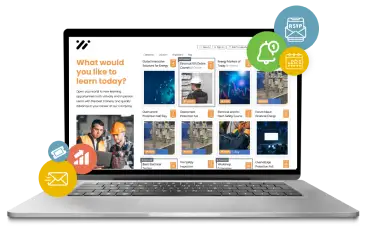
The Training Function in Human Resources Management (HRM)
In the world of business, a successful and competent workforce is crucial to achieving company goals and staying competitive in today's dynamic markets. Among the critical roles within this is the Training Function of Human Resources Management (HRM). Since it ensures that employees are sufficiently equipped to perform their jobs at optimum levels. Therefore, this article will delve into the critical definitions associated with employee training in HRM, elucidate various strategies employed for job training and development, and spotlight the newest technologies in play for workforce development. So, join us as we explore this integral facet of HRM and understand how it fuels businesses toward sustainable success.

I. What Is Training Function in HRM?
Human Resource Management (HRM) involves a variety of critical functions within an organization, including but not limited to recruitment, training, and employee relations. The training function, which is a pivotal component, focuses on employees' training and development to enhance their skills and capabilities, contributing to the overall growth and success of the organization.
Additionally, the term "Training Function" in HRM refers to the process of planning, organizing, and implementing training and development programs for employees within an organization. Furthermore, this human resources management function plays a crucial role in enhancing the skills, knowledge, and abilities of employees. As well as granting several benefits to employees and the company itself.
Finally, the training function of HRM aligns with an organization’s business strategy by prioritizing training and development of employees. The ultimate objective is to enhance their performance, productivity, and overall value to the organization.

II. How To Set Up A Job Training And Development Environment
Setting up a job training and development ecosystem within an organization involves creating a holistic and sustainable framework. That is, one that encompasses continuous employee learning, growth, and skill development. Further, here are 10 steps to help you establish an effective HR training ecosystem:
1. Make A Snapshot Analysis of the Current Situation
- Identify organizational goals and objectives: Understand the overarching business goals and objectives that HR training and development initiatives should support.
- Assess current skills and knowledge: Conduct a skills gap analysis to determine the areas where employees need training and development.
- Analyze existing employee training programs: Review any existing HR training and development initiatives to assess their effectiveness and alignment with organizational goals.
2. Foster Strategic Stakeholder Engagement
- Involve key stakeholders: Engage HR professionals, managers, executives, and employees in discussions to gather their input and support for training and development initiatives.
- Create a steering committee: Form a dedicated team responsible for overseeing the design and implementation of the training and development ecosystem.

3. Define HR Training and Development Objectives
- Specify clear learning objectives: Determine what you want employees to learn and achieve through the training and development ecosystem.
- Align with business goals: Ensure that employees training objectives are closely aligned with the organization's strategic objectives.
4. Design Personalized Learning Paths in The Training Function
- Create customized learning paths: Develop a structured curriculum that includes various learning resources such as courses, workshops, on-the-job training, mentorship, and self-paced e-learning modules.
- Personalize learning journeys: Tailor learning paths to individual employee needs, career goals, and skill gaps.
5. Select Training and Development Technologies
- Invest in learning platforms: Choose training management systems (TMS) or learning experience platforms (LXP) to host and manage digital learning resources.
- Explore emerging technologies: Consider incorporating innovative technologies like virtual reality (VR), augmented reality (AR), and artificial intelligence (AI) for more engaging and effective learning experiences.
6. Content Development
- Create or curate content: Develop high-quality employee training materials, or curate content from reputable sources, to support the learning paths.
- Develop multimedia resources: Include a mix of videos, interactive modules, written materials, and other multimedia formats to cater to diverse learning styles.
7. Delivery Methods
- Offer multiple delivery options: Provide flexibility by offering in-person, virtual, blended, and self-paced learning options. And therefore accommodate different learning preferences and work schedules.
8. Measurement and Evaluation
- Define KPIs and metrics: Establish key performance indicators (KPIs) for the company's HRM training function to measure the effectiveness of the training and development ecosystem.
- Regularly assess progress: Monitor employee performance, skill development, and engagement throughout the learning journey.
- Gather feedback: Collect feedback from learners and managers to make continuous improvements to your HR training programs.
- Regularly assess the impact: Conduct periodic evaluations to measure the ROI and effectiveness of the training and development ecosystem and share the results with stakeholders.

9. Continuous Improvement
- Stay updated: Keep the training and development ecosystem relevant by reading training magazines and staying current with HR tech trends.
- Adapt to changing needs: Be flexible and ready to adjust the human resources training ecosystem as organizational goals and employee development needs change over time.
10. Promote a Learning Culture
- Encourage a culture of learning: Promote a mindset where continuous learning is valued and integrated into the organization's DNA.
- Recognize and reward learning achievements: Acknowledge and celebrate employee accomplishments in their development and training journey.
- Communicate training and development opportunities: Ensure employees are aware of available learning resources and how they can access them. Use a training calendar on your website to display the upcoming courses and activities to engage employees.
- Encourage participation: Actively promote and encourage employee engagement in training and development activities.
- Allocate resources: Allocate budget and allocate necessary personnel and technology resources to support HR training initiatives effectively.
Finally, establishing a robust job training and development ecosystem requires ongoing commitment. Furthermore, it requires investment and collaboration among various stakeholders to ensure that it aligns with organizational goals and contributes to the growth and success of both individuals and the organization as a whole.
III. Five Key Technologies to Accelerate the Training Function
Lets explore five game-changing technologies for turbocharging your training function. In today's competitive landscape, effective employee development is paramount. Consequently, these technologies can revolutionize your approach, making training in human resources more efficient, engaging, and data-driven:
- Training Management Systems: Implement a TMS to centralize corporate training promotion and course registration, track employee attendance, and generate reports on training effectiveness.
- Virtual Reality and Augmented Reality: Use VR and AR technologies for immersive and hands-on training experiences, particularly for technical or complex skills.
- E-Learning Authoring Tools: Create custom e-learning modules using authoring tools like Articulate Storyline or Adobe Captivate to provide self-paced, interactive content.
- Video Conferencing and Webinar Platforms: Host virtual training sessions and webinars using platforms like Zoom, Microsoft Teams, or Webex to reach geographically dispersed teams.
- Gamification: Incorporate gamification elements into human resources training programs to increase engagement and motivation. Therefore, gamified platforms like Kahoot! can be beneficial.
Lastly, by leveraging technology in these ways, organizations can make their training function more efficient, scalable, and engaging. Technology can also provide valuable data and insights that enable continuous improvement and better alignment of the training and development role of human resource management with organizational goals.

IV. FAQs About The Training Function in Human Resources Management:
1. What Is The Training Function In HRM?
The training function in Human Resources Management (HRM) refers to the systematic process of planning, organizing, and implementing training and development programs for employees within an organization. Its primary aim is to enhance employees' skills, knowledge, and capabilities to improve their job performance, productivity, and overall contribution to the organization.
Moreover, this function involves identifying training needs, designing relevant training programs, delivering them through various methods, and assessing their effectiveness. Essentially, it is a vital HRM component that ensures employees are equipped with the necessary skills and knowledge to meet both individual and organizational goals.
2. What Are Some Common Methods Used In Job Training And Development Programs?
Job training and development programs utilize a range of methods to enhance employee skills and knowledge. These methods encompass traditional classroom training and workshops, as well as modern approaches like e-learning, simulations, and virtual reality (VR) or augmented reality (AR) experiences.
Moreover, mentoring and coaching offer personalized guidance, while role-playing and peer learning promote practical skills and collaborative problem-solving. Additionally, organizations often employ blended learning, combining various methods to create comprehensive training programs. Job rotation and cross-training enhance versatility, and gamification elements increase engagement and motivation.
Further, with these diverse methods at their disposal, organizations can tailor HR training programs to suit their specific needs and objectives effectively, fulfilling their training function.
3. How Can Organizations Harness Technology To Enhance Training And Development Strategies?
Technology plays a pivotal role in modern training and development strategies. They make it easier for human resource departments to carry out their training function. For example, utilizing training management systems, like Timely training management software, streamlines training promotion and registration, while data analytics enables progress monitoring and improvement.
Also, by embracing technological tools, organizations can optimize their training programs, resulting in a more skilled and adaptable workforce.
4. How Does Timely Improve Training and Development Programs?
Timely significantly enhances training and development programs by simplifying training courses promotion, scheduling and registration. Indeed, Timely's white-label calendar integration feature enhances training information accessibility on an organization's website. Therefore, presenting a professional and branded experience for employees. Furthermore, Timely's thorough Help Center is a great tool for seamless integration of the software and user experience.
Table of Contents

Event Management Updates
If you want to know more Timely company and product update news, please visit our Event Management Blog. There is always something new happening at Timely, so we do our best to keep our clients on the loop!
You might also like







